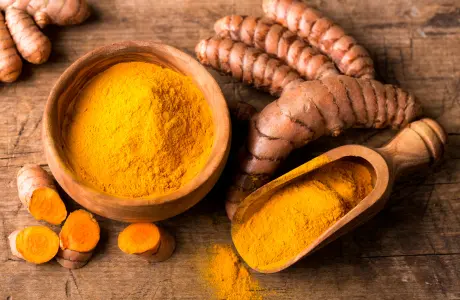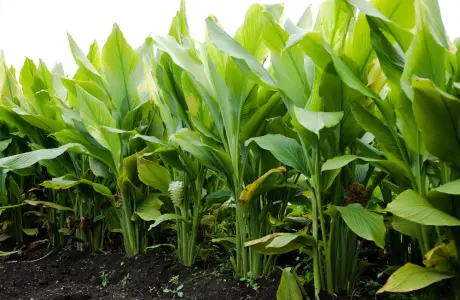What is Turmeric
Zplux Technologies2024-12-26T18:22:42+00:00What is Turmeric?
History, Uses, Benefits, and More

Turmeric: Nature’s Golden Root
The term “turmeric” refers to the rhizome, or root, of a green, leafy tropical plant. It also describes the vibrant yellow spice made by processing this rhizome. Over time, Turmeric and its primary active compound, Curcumin, have been extensively studied for their potential in addressing a variety of health conditions.
Unveiling Turmeric: Nature’s Golden Remedy
Discover the origins, benefits, and versatile uses of Turmeric—an ancient root celebrated for its powerful healing properties and modern-day wellness applications.
Ancient Wisdom, Modern Wellness
Turmeric has been cherished for centuries as a natural remedy and culinary staple. Known as the “Golden Spice,” its roots trace back to ancient traditions where it was celebrated for its healing properties. Today, modern science validates its incredible benefits, from reducing inflammation to enhancing overall health. Discover how this powerful root bridges the gap between traditional wisdom and cutting-edge wellness solutions.
The Turmeric Plant
The Turmeric plant has been an integral part of human culture for over 4,000 years. This perennial herbaceous plant grows from a rhizome, or root, and thrives in warm, humid climates with temperatures ranging from 68 to 86°F and ample rainfall. It is primarily cultivated in the hilly regions of India, where the conditions are ideal for its growth. When you think of “Turmeric,” the vibrant yellow-orange spice likely comes to mind. This spice, known for giving Indian curry powder its distinctive color, is derived from the dried and processed root of the Turmeric plant. Beyond the powdered spice, Turmeric is consumed in various forms, including fresh rhizomes, leaves, turmeric oil, and curcumin extract, making it a versatile ingredient in both culinary and wellness applications.

A Member of the Ginger Family
Turmeric, a perennial herbaceous plant, is a close relative of ginger, galangal, and cardamom. With over a hundred species, the most widely cultivated for human use is Curcuma longa, belonging to the Zingiberaceae family. Native to India and Southeast Asia, Turmeric is now grown in tropical climates worldwide, thanks to its rich cultural and medicinal significance.
Turmeric Cultivation
India leads the world in Turmeric production, cultivating over 80% of the global supply. Spanning more than 140,000 hectares and yielding 650,000 tons annually, Turmeric is deeply rooted in India’s agricultural and cultural heritage. Other tropical and subtropical regions, including Indonesia, Australia, Central America, and the Caribbean, have also embraced Turmeric cultivation, recognizing its global value.
The Turmeric Root and Leaves
Turmeric plants grow to about three feet tall, producing bright green leaves and colorful flowers. Beneath the surface, the plant forms rhizomes—finger-like roots with vibrant orange interiors. These rhizomes are processed to produce the Turmeric powder we know today, widely used for culinary, medicinal, and cosmetic purposes.
From Root to Spice: The Production of Turmeric Powder
Turning Turmeric rhizomes into the aromatic, health-boosting spice involves several steps:
Cleaning: Harvested rhizomes are cleaned and peeled.
Boiling: The roots are boiled or steamed to soften them and enhance their vibrant color.
Drying: Rhizomes are dried either naturally or using heat, ensuring optimal moisture levels.
Polishing and Milling: Once dried, the rhizomes are polished and ground into a fine powder.
The Nutrients in Turmeric
Turning Turmeric rhizomes into the aromatic, health-boosting spice involves several steps:
What Is Curcumin?
Curcumin, the primary bioactive compound in Turmeric, is a potent anti-inflammatory and antioxidant agent. Although it makes up only 2-5% of Turmeric root, its benefits are significant, ranging from reducing inflammation to fighting free radicals. Studies have shown that combining Curcumin with piperine (found in black pepper) increases its absorption by up to 2000%, maximizing its health benefits.
Why Choose a Curcumin Extract?
While powdered Turmeric contains Curcumin, it’s often not enough to deliver therapeutic benefits. Curcumin extracts, standardized to 95% concentration and combined with piperine, provide a highly potent dose, ensuring maximum efficacy.
Why Turmeric?
Turmeric has stood the test of time as a versatile and powerful natural remedy. Its modern applications, backed by science, confirm its ability to improve overall health and manage various medical conditions. From joint health to cognitive support, this golden root remains a vital part of wellness traditions worldwide.
Concluding Thoughts
Turmeric is more than a spice—it’s a powerful ally for your health. By choosing a high-quality Turmeric supplement with standardized Curcumin and enhanced bioavailability, you can unlock its full potential. Explore BYGA Wellness’s Premium Turmeric Supplements and discover the difference that trusted quality and advanced formulations can make in your journey toward better health.
